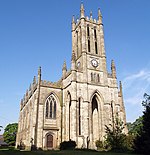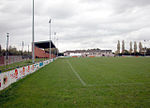Whitefield Town Hall
Buildings and structures demolished in 2021City and town halls in Greater ManchesterDemolished buildings and structures in Greater ManchesterGovernment buildings completed in 1805Pages containing London Gazette template with parameter supp set to y ... and 2 more
Use British English from March 2024Whitefield, Greater Manchester

Whitefield Town Hall was a municipal building off Pinfold Lane, Whitefield, a town in Greater Manchester in England. The building, which served as the offices and meeting place of Whitefield Urban District Council, was demolished in 2021.
Excerpt from the Wikipedia article Whitefield Town Hall (License: CC BY-SA 3.0, Authors, Images).Whitefield Town Hall
Bury New Road,
Geographical coordinates (GPS) Address Nearby Places Show on map
Geographical coordinates (GPS)
| Latitude | Longitude |
|---|---|
| N 53.5479 ° | E -2.2954 ° |
Address
Bury New Road
M45 6GG , Besses o' th' Barn
England, United Kingdom
Open on Google Maps









